Business Process Intelligence: Analysis and Literature Review Report
VerifiedAdded on 2022/09/17
|10
|2052
|20
Report
AI Summary
This report provides a comprehensive literature review on Business Process Intelligence (BPI), focusing on the application of data mining and data warehousing within business process management. It explores how BPI tools and techniques are utilized to analyze and optimize business processes from both IT and business perspectives. The report examines the roles of data mining in extracting, transforming, and loading data into data warehouses, highlighting its use in customer relationship management and strategic decision-making. Furthermore, it discusses data warehousing's role in providing accurate and reliable data through ETL processes, enabling multi-dimensional queries and historical data analysis. The report also covers the business process cockpit, which enables business-level quality analysis. The conclusion emphasizes the importance of BPI for organizational development, the adoption of big data analytics, and the potential for future advancements, particularly with the integration of the Internet of Things.
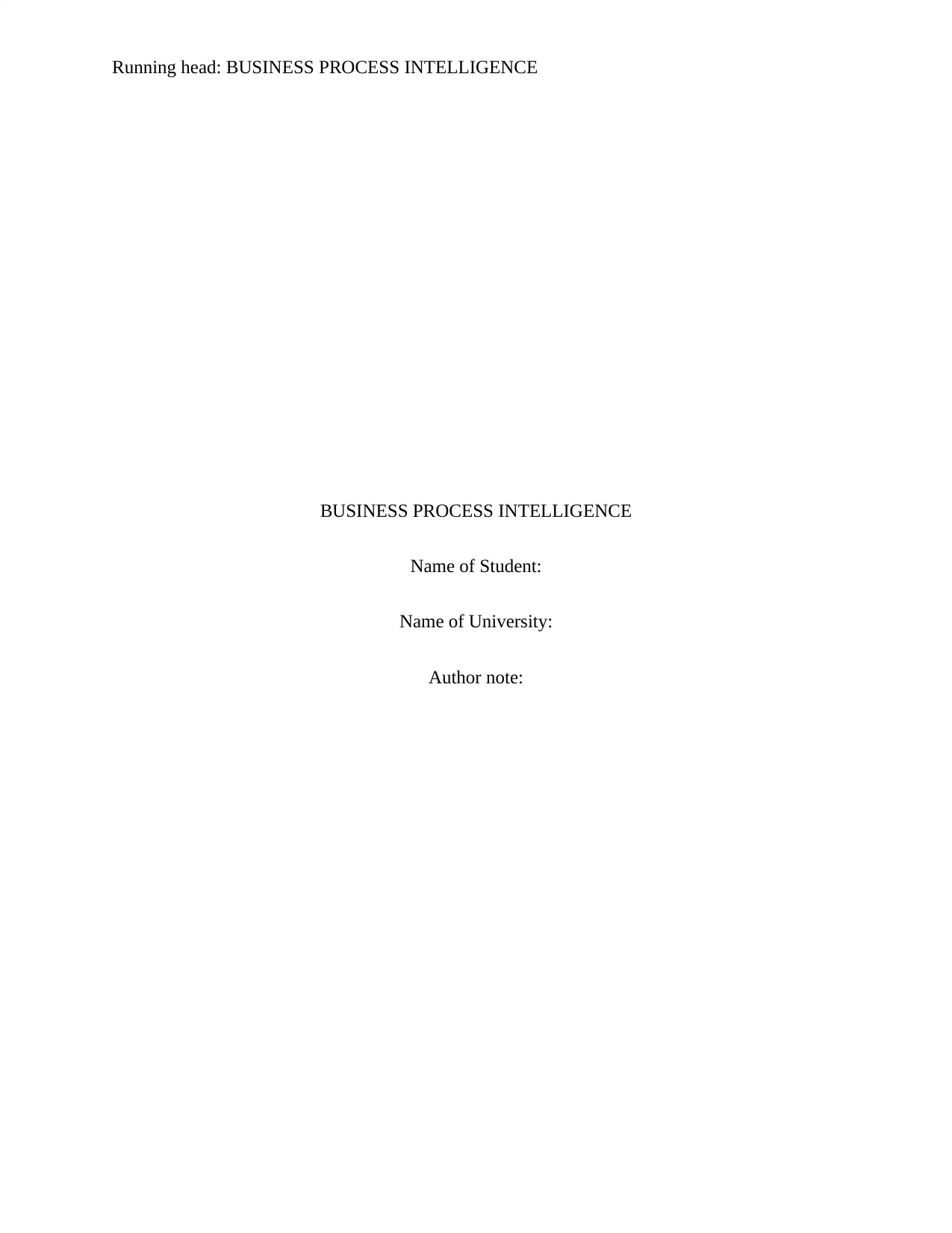
Running head: BUSINESS PROCESS INTELLIGENCE
BUSINESS PROCESS INTELLIGENCE
Name of Student:
Name of University:
Author note:
BUSINESS PROCESS INTELLIGENCE
Name of Student:
Name of University:
Author note:
Paraphrase This Document
Need a fresh take? Get an instant paraphrase of this document with our AI Paraphraser
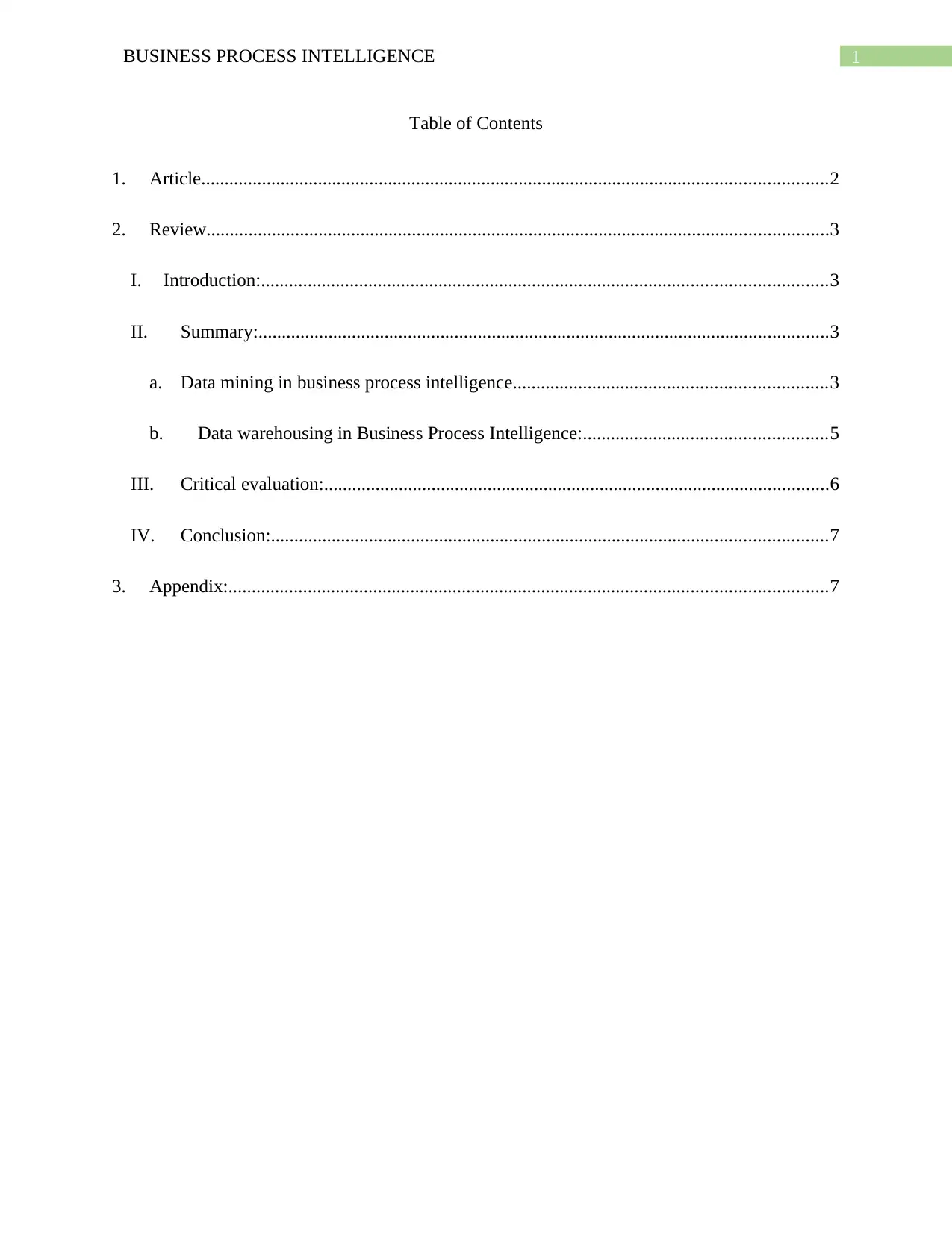
1BUSINESS PROCESS INTELLIGENCE
Table of Contents
1. Article......................................................................................................................................2
2. Review.....................................................................................................................................3
I. Introduction:.........................................................................................................................3
II. Summary:..........................................................................................................................3
a. Data mining in business process intelligence...................................................................3
b. Data warehousing in Business Process Intelligence:....................................................5
III. Critical evaluation:............................................................................................................6
IV. Conclusion:.......................................................................................................................7
3. Appendix:................................................................................................................................7
Table of Contents
1. Article......................................................................................................................................2
2. Review.....................................................................................................................................3
I. Introduction:.........................................................................................................................3
II. Summary:..........................................................................................................................3
a. Data mining in business process intelligence...................................................................3
b. Data warehousing in Business Process Intelligence:....................................................5
III. Critical evaluation:............................................................................................................6
IV. Conclusion:.......................................................................................................................7
3. Appendix:................................................................................................................................7

2BUSINESS PROCESS INTELLIGENCE
1. Article:
Business Process Intelligence (Casati et al., 2002).
1. Article:
Business Process Intelligence (Casati et al., 2002).
⊘ This is a preview!⊘
Do you want full access?
Subscribe today to unlock all pages.

Trusted by 1+ million students worldwide
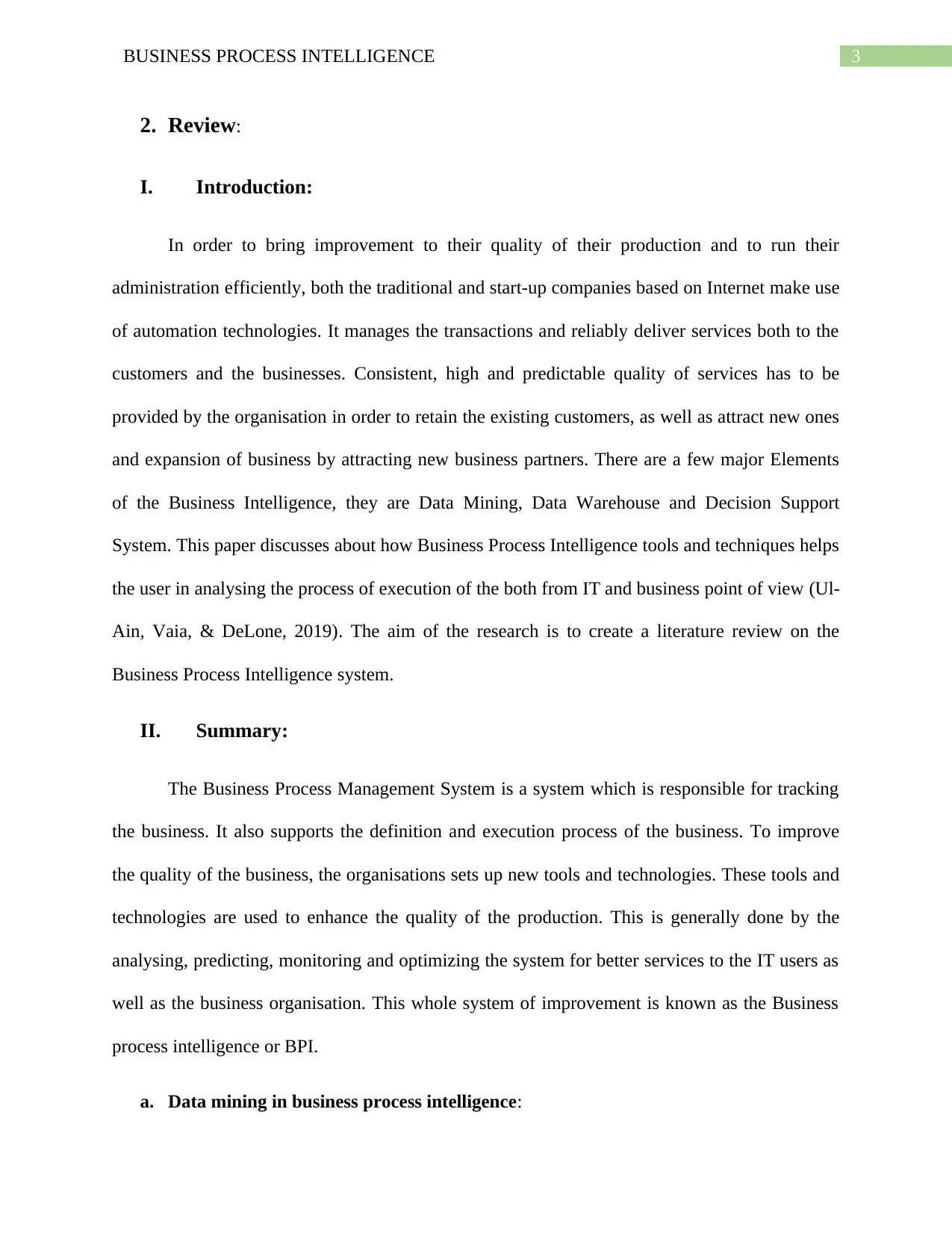
3BUSINESS PROCESS INTELLIGENCE
2. Review:
I. Introduction:
In order to bring improvement to their quality of their production and to run their
administration efficiently, both the traditional and start-up companies based on Internet make use
of automation technologies. It manages the transactions and reliably deliver services both to the
customers and the businesses. Consistent, high and predictable quality of services has to be
provided by the organisation in order to retain the existing customers, as well as attract new ones
and expansion of business by attracting new business partners. There are a few major Elements
of the Business Intelligence, they are Data Mining, Data Warehouse and Decision Support
System. This paper discusses about how Business Process Intelligence tools and techniques helps
the user in analysing the process of execution of the both from IT and business point of view (Ul-
Ain, Vaia, & DeLone, 2019). The aim of the research is to create a literature review on the
Business Process Intelligence system.
II. Summary:
The Business Process Management System is a system which is responsible for tracking
the business. It also supports the definition and execution process of the business. To improve
the quality of the business, the organisations sets up new tools and technologies. These tools and
technologies are used to enhance the quality of the production. This is generally done by the
analysing, predicting, monitoring and optimizing the system for better services to the IT users as
well as the business organisation. This whole system of improvement is known as the Business
process intelligence or BPI.
a. Data mining in business process intelligence:
2. Review:
I. Introduction:
In order to bring improvement to their quality of their production and to run their
administration efficiently, both the traditional and start-up companies based on Internet make use
of automation technologies. It manages the transactions and reliably deliver services both to the
customers and the businesses. Consistent, high and predictable quality of services has to be
provided by the organisation in order to retain the existing customers, as well as attract new ones
and expansion of business by attracting new business partners. There are a few major Elements
of the Business Intelligence, they are Data Mining, Data Warehouse and Decision Support
System. This paper discusses about how Business Process Intelligence tools and techniques helps
the user in analysing the process of execution of the both from IT and business point of view (Ul-
Ain, Vaia, & DeLone, 2019). The aim of the research is to create a literature review on the
Business Process Intelligence system.
II. Summary:
The Business Process Management System is a system which is responsible for tracking
the business. It also supports the definition and execution process of the business. To improve
the quality of the business, the organisations sets up new tools and technologies. These tools and
technologies are used to enhance the quality of the production. This is generally done by the
analysing, predicting, monitoring and optimizing the system for better services to the IT users as
well as the business organisation. This whole system of improvement is known as the Business
process intelligence or BPI.
a. Data mining in business process intelligence:
Paraphrase This Document
Need a fresh take? Get an instant paraphrase of this document with our AI Paraphraser
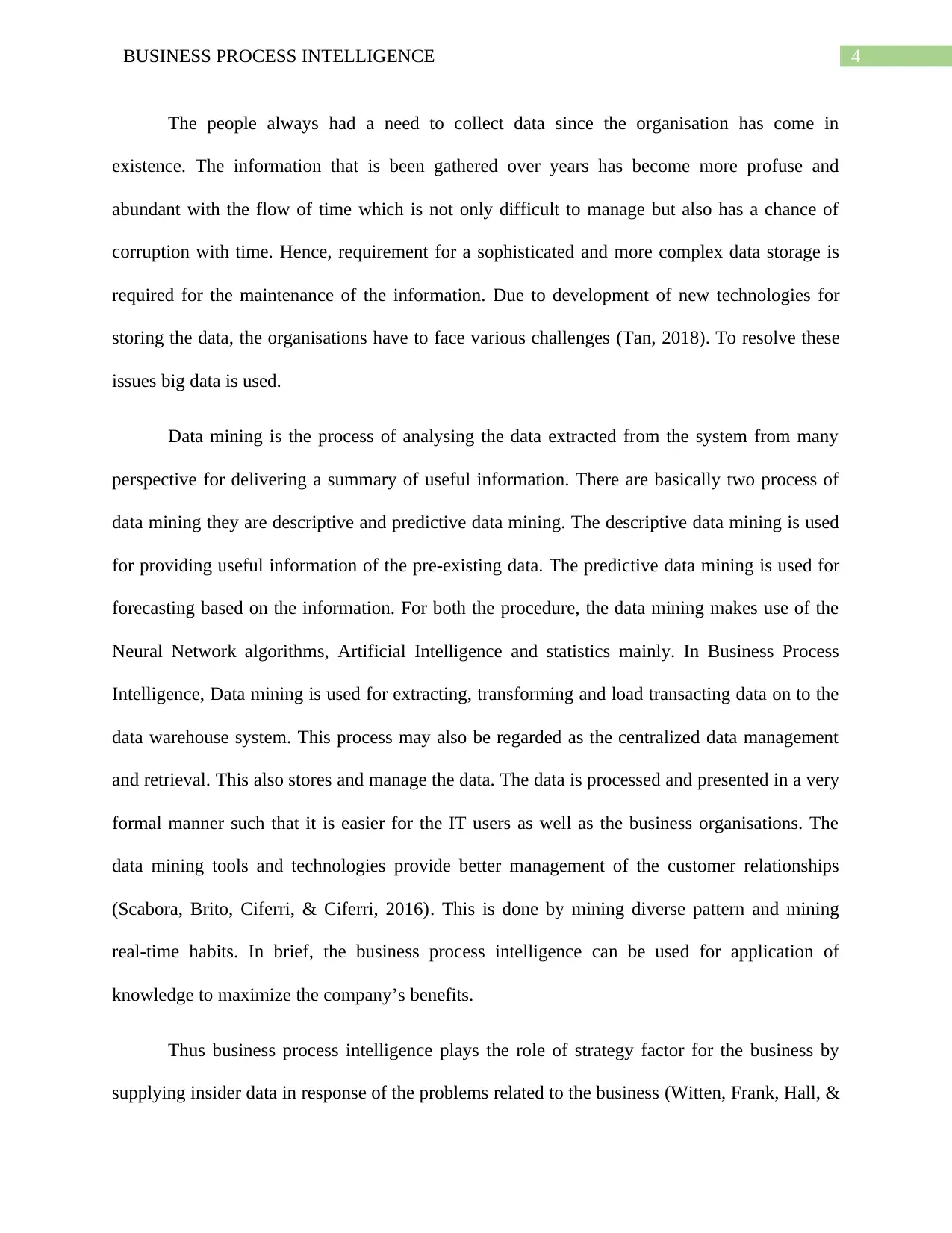
4BUSINESS PROCESS INTELLIGENCE
The people always had a need to collect data since the organisation has come in
existence. The information that is been gathered over years has become more profuse and
abundant with the flow of time which is not only difficult to manage but also has a chance of
corruption with time. Hence, requirement for a sophisticated and more complex data storage is
required for the maintenance of the information. Due to development of new technologies for
storing the data, the organisations have to face various challenges (Tan, 2018). To resolve these
issues big data is used.
Data mining is the process of analysing the data extracted from the system from many
perspective for delivering a summary of useful information. There are basically two process of
data mining they are descriptive and predictive data mining. The descriptive data mining is used
for providing useful information of the pre-existing data. The predictive data mining is used for
forecasting based on the information. For both the procedure, the data mining makes use of the
Neural Network algorithms, Artificial Intelligence and statistics mainly. In Business Process
Intelligence, Data mining is used for extracting, transforming and load transacting data on to the
data warehouse system. This process may also be regarded as the centralized data management
and retrieval. This also stores and manage the data. The data is processed and presented in a very
formal manner such that it is easier for the IT users as well as the business organisations. The
data mining tools and technologies provide better management of the customer relationships
(Scabora, Brito, Ciferri, & Ciferri, 2016). This is done by mining diverse pattern and mining
real-time habits. In brief, the business process intelligence can be used for application of
knowledge to maximize the company’s benefits.
Thus business process intelligence plays the role of strategy factor for the business by
supplying insider data in response of the problems related to the business (Witten, Frank, Hall, &
The people always had a need to collect data since the organisation has come in
existence. The information that is been gathered over years has become more profuse and
abundant with the flow of time which is not only difficult to manage but also has a chance of
corruption with time. Hence, requirement for a sophisticated and more complex data storage is
required for the maintenance of the information. Due to development of new technologies for
storing the data, the organisations have to face various challenges (Tan, 2018). To resolve these
issues big data is used.
Data mining is the process of analysing the data extracted from the system from many
perspective for delivering a summary of useful information. There are basically two process of
data mining they are descriptive and predictive data mining. The descriptive data mining is used
for providing useful information of the pre-existing data. The predictive data mining is used for
forecasting based on the information. For both the procedure, the data mining makes use of the
Neural Network algorithms, Artificial Intelligence and statistics mainly. In Business Process
Intelligence, Data mining is used for extracting, transforming and load transacting data on to the
data warehouse system. This process may also be regarded as the centralized data management
and retrieval. This also stores and manage the data. The data is processed and presented in a very
formal manner such that it is easier for the IT users as well as the business organisations. The
data mining tools and technologies provide better management of the customer relationships
(Scabora, Brito, Ciferri, & Ciferri, 2016). This is done by mining diverse pattern and mining
real-time habits. In brief, the business process intelligence can be used for application of
knowledge to maximize the company’s benefits.
Thus business process intelligence plays the role of strategy factor for the business by
supplying insider data in response of the problems related to the business (Witten, Frank, Hall, &
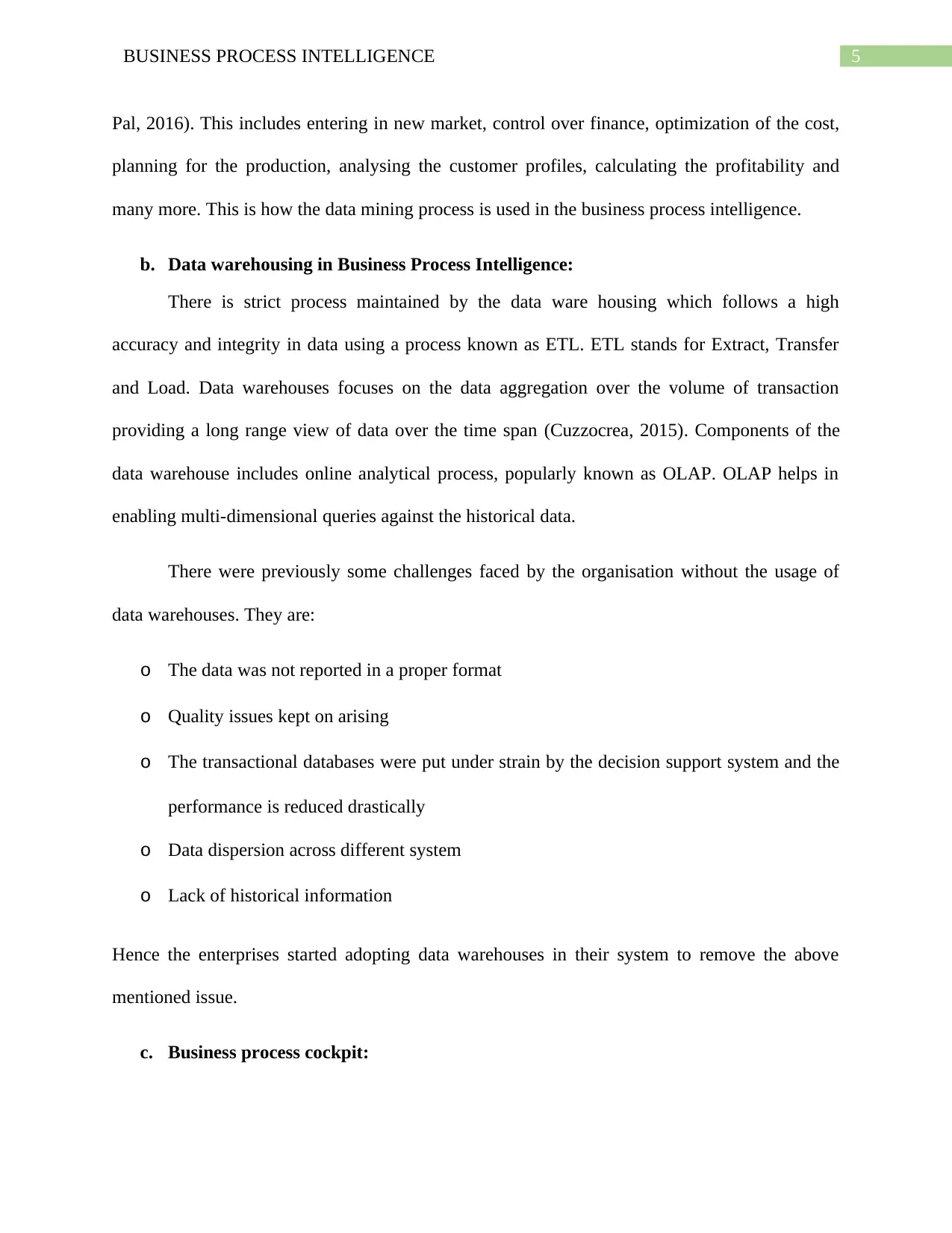
5BUSINESS PROCESS INTELLIGENCE
Pal, 2016). This includes entering in new market, control over finance, optimization of the cost,
planning for the production, analysing the customer profiles, calculating the profitability and
many more. This is how the data mining process is used in the business process intelligence.
b. Data warehousing in Business Process Intelligence:
There is strict process maintained by the data ware housing which follows a high
accuracy and integrity in data using a process known as ETL. ETL stands for Extract, Transfer
and Load. Data warehouses focuses on the data aggregation over the volume of transaction
providing a long range view of data over the time span (Cuzzocrea, 2015). Components of the
data warehouse includes online analytical process, popularly known as OLAP. OLAP helps in
enabling multi-dimensional queries against the historical data.
There were previously some challenges faced by the organisation without the usage of
data warehouses. They are:
o The data was not reported in a proper format
o Quality issues kept on arising
o The transactional databases were put under strain by the decision support system and the
performance is reduced drastically
o Data dispersion across different system
o Lack of historical information
Hence the enterprises started adopting data warehouses in their system to remove the above
mentioned issue.
c. Business process cockpit:
Pal, 2016). This includes entering in new market, control over finance, optimization of the cost,
planning for the production, analysing the customer profiles, calculating the profitability and
many more. This is how the data mining process is used in the business process intelligence.
b. Data warehousing in Business Process Intelligence:
There is strict process maintained by the data ware housing which follows a high
accuracy and integrity in data using a process known as ETL. ETL stands for Extract, Transfer
and Load. Data warehouses focuses on the data aggregation over the volume of transaction
providing a long range view of data over the time span (Cuzzocrea, 2015). Components of the
data warehouse includes online analytical process, popularly known as OLAP. OLAP helps in
enabling multi-dimensional queries against the historical data.
There were previously some challenges faced by the organisation without the usage of
data warehouses. They are:
o The data was not reported in a proper format
o Quality issues kept on arising
o The transactional databases were put under strain by the decision support system and the
performance is reduced drastically
o Data dispersion across different system
o Lack of historical information
Hence the enterprises started adopting data warehouses in their system to remove the above
mentioned issue.
c. Business process cockpit:
⊘ This is a preview!⊘
Do you want full access?
Subscribe today to unlock all pages.

Trusted by 1+ million students worldwide
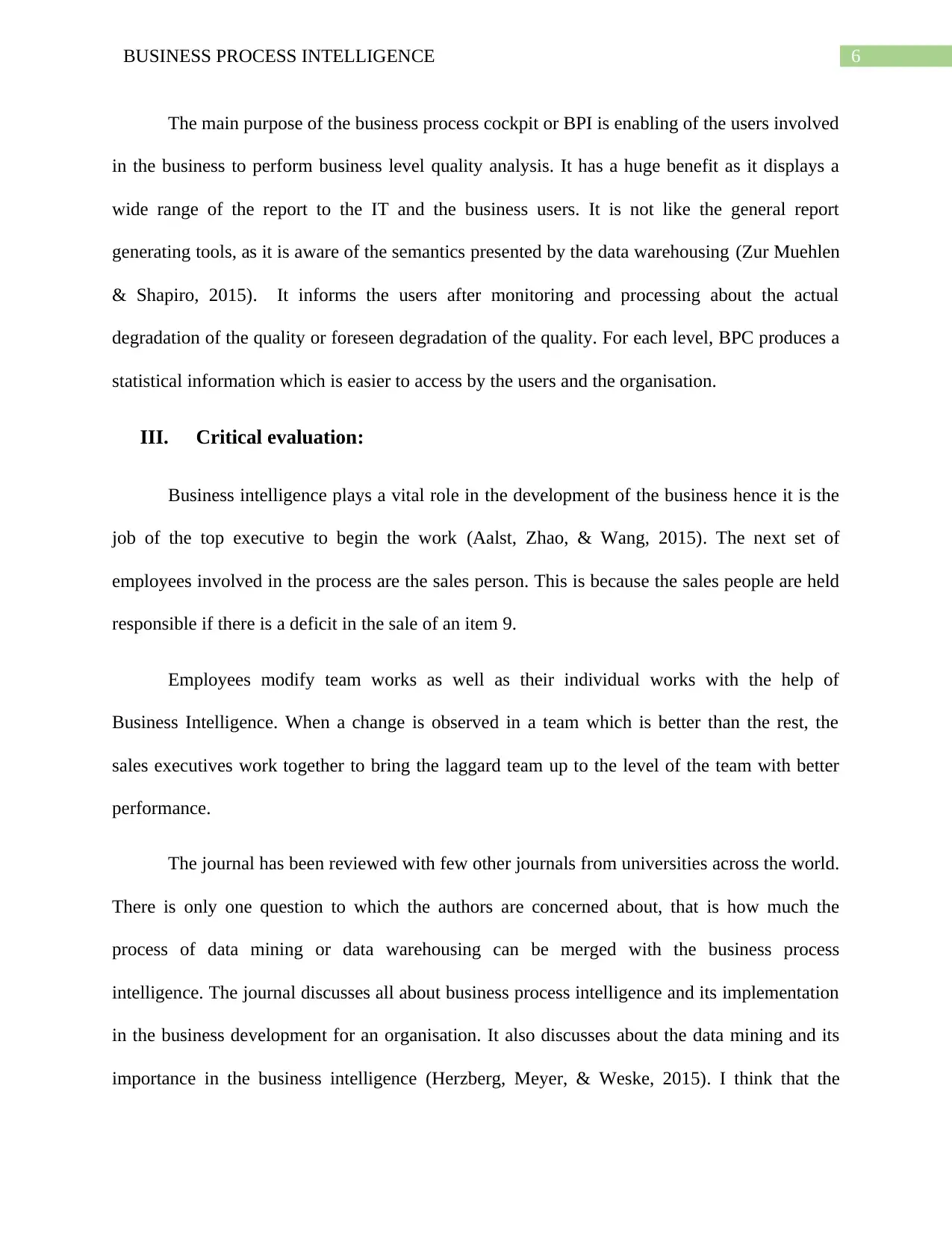
6BUSINESS PROCESS INTELLIGENCE
The main purpose of the business process cockpit or BPI is enabling of the users involved
in the business to perform business level quality analysis. It has a huge benefit as it displays a
wide range of the report to the IT and the business users. It is not like the general report
generating tools, as it is aware of the semantics presented by the data warehousing (Zur Muehlen
& Shapiro, 2015). It informs the users after monitoring and processing about the actual
degradation of the quality or foreseen degradation of the quality. For each level, BPC produces a
statistical information which is easier to access by the users and the organisation.
III. Critical evaluation:
Business intelligence plays a vital role in the development of the business hence it is the
job of the top executive to begin the work (Aalst, Zhao, & Wang, 2015). The next set of
employees involved in the process are the sales person. This is because the sales people are held
responsible if there is a deficit in the sale of an item 9.
Employees modify team works as well as their individual works with the help of
Business Intelligence. When a change is observed in a team which is better than the rest, the
sales executives work together to bring the laggard team up to the level of the team with better
performance.
The journal has been reviewed with few other journals from universities across the world.
There is only one question to which the authors are concerned about, that is how much the
process of data mining or data warehousing can be merged with the business process
intelligence. The journal discusses all about business process intelligence and its implementation
in the business development for an organisation. It also discusses about the data mining and its
importance in the business intelligence (Herzberg, Meyer, & Weske, 2015). I think that the
The main purpose of the business process cockpit or BPI is enabling of the users involved
in the business to perform business level quality analysis. It has a huge benefit as it displays a
wide range of the report to the IT and the business users. It is not like the general report
generating tools, as it is aware of the semantics presented by the data warehousing (Zur Muehlen
& Shapiro, 2015). It informs the users after monitoring and processing about the actual
degradation of the quality or foreseen degradation of the quality. For each level, BPC produces a
statistical information which is easier to access by the users and the organisation.
III. Critical evaluation:
Business intelligence plays a vital role in the development of the business hence it is the
job of the top executive to begin the work (Aalst, Zhao, & Wang, 2015). The next set of
employees involved in the process are the sales person. This is because the sales people are held
responsible if there is a deficit in the sale of an item 9.
Employees modify team works as well as their individual works with the help of
Business Intelligence. When a change is observed in a team which is better than the rest, the
sales executives work together to bring the laggard team up to the level of the team with better
performance.
The journal has been reviewed with few other journals from universities across the world.
There is only one question to which the authors are concerned about, that is how much the
process of data mining or data warehousing can be merged with the business process
intelligence. The journal discusses all about business process intelligence and its implementation
in the business development for an organisation. It also discusses about the data mining and its
importance in the business intelligence (Herzberg, Meyer, & Weske, 2015). I think that the
Paraphrase This Document
Need a fresh take? Get an instant paraphrase of this document with our AI Paraphraser
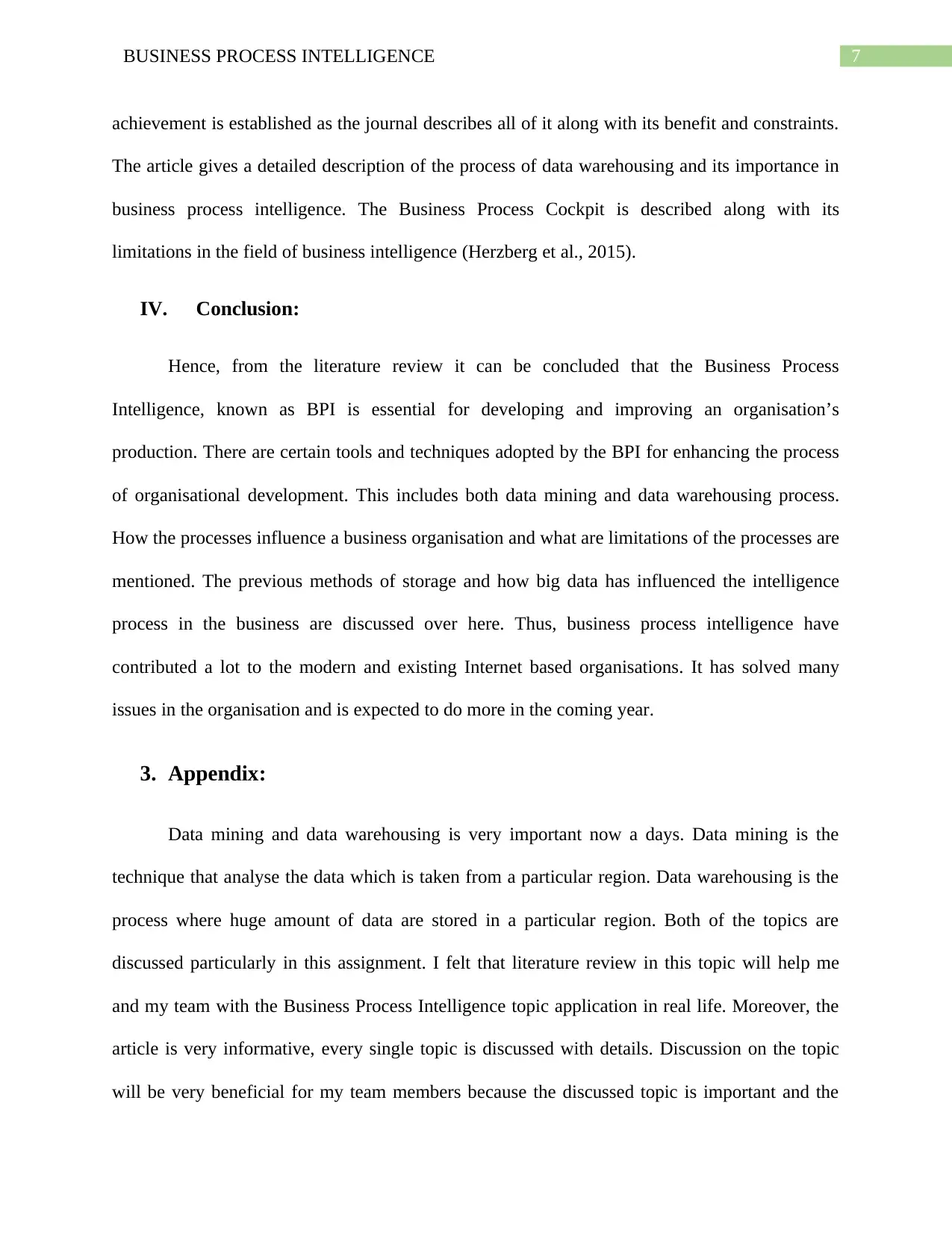
7BUSINESS PROCESS INTELLIGENCE
achievement is established as the journal describes all of it along with its benefit and constraints.
The article gives a detailed description of the process of data warehousing and its importance in
business process intelligence. The Business Process Cockpit is described along with its
limitations in the field of business intelligence (Herzberg et al., 2015).
IV. Conclusion:
Hence, from the literature review it can be concluded that the Business Process
Intelligence, known as BPI is essential for developing and improving an organisation’s
production. There are certain tools and techniques adopted by the BPI for enhancing the process
of organisational development. This includes both data mining and data warehousing process.
How the processes influence a business organisation and what are limitations of the processes are
mentioned. The previous methods of storage and how big data has influenced the intelligence
process in the business are discussed over here. Thus, business process intelligence have
contributed a lot to the modern and existing Internet based organisations. It has solved many
issues in the organisation and is expected to do more in the coming year.
3. Appendix:
Data mining and data warehousing is very important now a days. Data mining is the
technique that analyse the data which is taken from a particular region. Data warehousing is the
process where huge amount of data are stored in a particular region. Both of the topics are
discussed particularly in this assignment. I felt that literature review in this topic will help me
and my team with the Business Process Intelligence topic application in real life. Moreover, the
article is very informative, every single topic is discussed with details. Discussion on the topic
will be very beneficial for my team members because the discussed topic is important and the
achievement is established as the journal describes all of it along with its benefit and constraints.
The article gives a detailed description of the process of data warehousing and its importance in
business process intelligence. The Business Process Cockpit is described along with its
limitations in the field of business intelligence (Herzberg et al., 2015).
IV. Conclusion:
Hence, from the literature review it can be concluded that the Business Process
Intelligence, known as BPI is essential for developing and improving an organisation’s
production. There are certain tools and techniques adopted by the BPI for enhancing the process
of organisational development. This includes both data mining and data warehousing process.
How the processes influence a business organisation and what are limitations of the processes are
mentioned. The previous methods of storage and how big data has influenced the intelligence
process in the business are discussed over here. Thus, business process intelligence have
contributed a lot to the modern and existing Internet based organisations. It has solved many
issues in the organisation and is expected to do more in the coming year.
3. Appendix:
Data mining and data warehousing is very important now a days. Data mining is the
technique that analyse the data which is taken from a particular region. Data warehousing is the
process where huge amount of data are stored in a particular region. Both of the topics are
discussed particularly in this assignment. I felt that literature review in this topic will help me
and my team with the Business Process Intelligence topic application in real life. Moreover, the
article is very informative, every single topic is discussed with details. Discussion on the topic
will be very beneficial for my team members because the discussed topic is important and the

8BUSINESS PROCESS INTELLIGENCE
particular article is also very informative. The details includes the work flow and the data flow in
the system which is effective and essential for the purpose of the developing an organisation.
Lastly, the application of the Big data analytics in the field of business development is a huge
advancement and can be developed further with the help of Internet of Things in this field.
particular article is also very informative. The details includes the work flow and the data flow in
the system which is effective and essential for the purpose of the developing an organisation.
Lastly, the application of the Big data analytics in the field of business development is a huge
advancement and can be developed further with the help of Internet of Things in this field.
⊘ This is a preview!⊘
Do you want full access?
Subscribe today to unlock all pages.

Trusted by 1+ million students worldwide
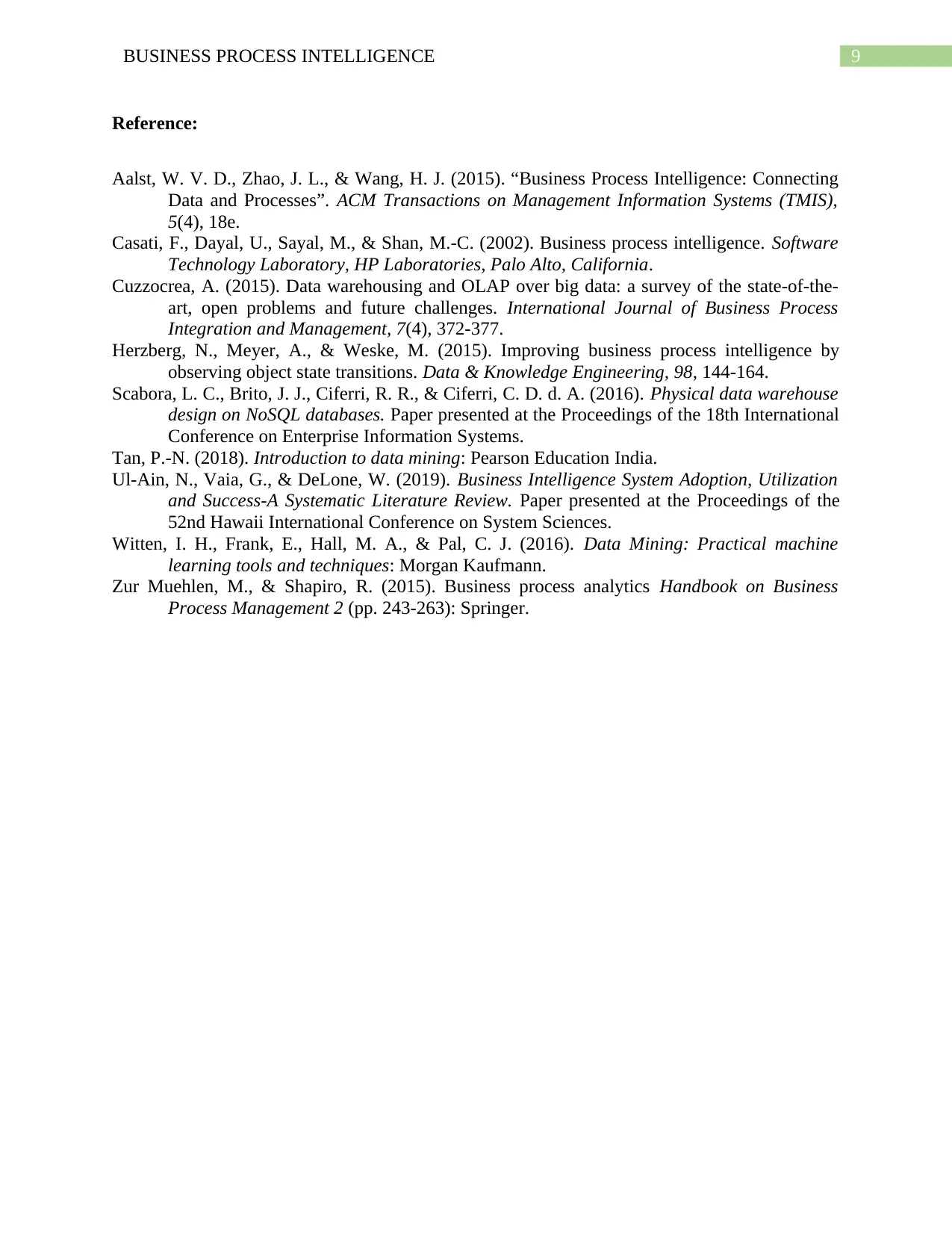
9BUSINESS PROCESS INTELLIGENCE
Reference:
Aalst, W. V. D., Zhao, J. L., & Wang, H. J. (2015). “Business Process Intelligence: Connecting
Data and Processes”. ACM Transactions on Management Information Systems (TMIS),
5(4), 18e.
Casati, F., Dayal, U., Sayal, M., & Shan, M.-C. (2002). Business process intelligence. Software
Technology Laboratory, HP Laboratories, Palo Alto, California.
Cuzzocrea, A. (2015). Data warehousing and OLAP over big data: a survey of the state-of-the-
art, open problems and future challenges. International Journal of Business Process
Integration and Management, 7(4), 372-377.
Herzberg, N., Meyer, A., & Weske, M. (2015). Improving business process intelligence by
observing object state transitions. Data & Knowledge Engineering, 98, 144-164.
Scabora, L. C., Brito, J. J., Ciferri, R. R., & Ciferri, C. D. d. A. (2016). Physical data warehouse
design on NoSQL databases. Paper presented at the Proceedings of the 18th International
Conference on Enterprise Information Systems.
Tan, P.-N. (2018). Introduction to data mining: Pearson Education India.
Ul-Ain, N., Vaia, G., & DeLone, W. (2019). Business Intelligence System Adoption, Utilization
and Success-A Systematic Literature Review. Paper presented at the Proceedings of the
52nd Hawaii International Conference on System Sciences.
Witten, I. H., Frank, E., Hall, M. A., & Pal, C. J. (2016). Data Mining: Practical machine
learning tools and techniques: Morgan Kaufmann.
Zur Muehlen, M., & Shapiro, R. (2015). Business process analytics Handbook on Business
Process Management 2 (pp. 243-263): Springer.
Reference:
Aalst, W. V. D., Zhao, J. L., & Wang, H. J. (2015). “Business Process Intelligence: Connecting
Data and Processes”. ACM Transactions on Management Information Systems (TMIS),
5(4), 18e.
Casati, F., Dayal, U., Sayal, M., & Shan, M.-C. (2002). Business process intelligence. Software
Technology Laboratory, HP Laboratories, Palo Alto, California.
Cuzzocrea, A. (2015). Data warehousing and OLAP over big data: a survey of the state-of-the-
art, open problems and future challenges. International Journal of Business Process
Integration and Management, 7(4), 372-377.
Herzberg, N., Meyer, A., & Weske, M. (2015). Improving business process intelligence by
observing object state transitions. Data & Knowledge Engineering, 98, 144-164.
Scabora, L. C., Brito, J. J., Ciferri, R. R., & Ciferri, C. D. d. A. (2016). Physical data warehouse
design on NoSQL databases. Paper presented at the Proceedings of the 18th International
Conference on Enterprise Information Systems.
Tan, P.-N. (2018). Introduction to data mining: Pearson Education India.
Ul-Ain, N., Vaia, G., & DeLone, W. (2019). Business Intelligence System Adoption, Utilization
and Success-A Systematic Literature Review. Paper presented at the Proceedings of the
52nd Hawaii International Conference on System Sciences.
Witten, I. H., Frank, E., Hall, M. A., & Pal, C. J. (2016). Data Mining: Practical machine
learning tools and techniques: Morgan Kaufmann.
Zur Muehlen, M., & Shapiro, R. (2015). Business process analytics Handbook on Business
Process Management 2 (pp. 243-263): Springer.
1 out of 10
Related Documents
Your All-in-One AI-Powered Toolkit for Academic Success.
+13062052269
info@desklib.com
Available 24*7 on WhatsApp / Email
![[object Object]](/_next/static/media/star-bottom.7253800d.svg)
Unlock your academic potential
Copyright © 2020–2025 A2Z Services. All Rights Reserved. Developed and managed by ZUCOL.





